Raspberry variety Monomakh's cap
Many argue that the variety is new, and therefore there is little information about it. But this could be at a time when there was no Internet and all kinds of country and horticultural forums. Now, when an interesting renovation novelty appears, two, maximum three years are enough for its objective characteristics to be more or less clear. Now it is 2018, and in 2011 S.N. Evdokimenko pointed out in the comments to the description of the variety: “Monomakh's hat is not registered. Began to be greatly affected by the virus, and we stopped multiplying it. " We think that in 7 years it is possible to add a clear and clear picture about this raspberry. True, there is really little information, it is sometimes contradictory and superficial. But we will try to fully describe and reveal the features of the heroine of our article. To one controversial question about the removal of a variety from registration, we answered above with a quote from a person who was directly involved in its creation. For other questions - in our article below.
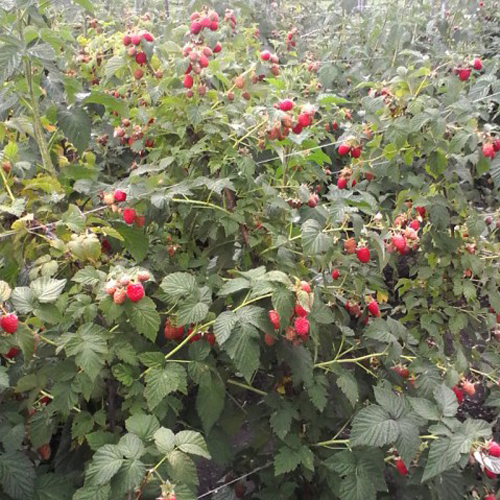
History of creation
This variety of remontant raspberries was bred by Russian breeders - Academician of the Russian Academy of Agricultural Sciences I.V. Kazakov and his student, Doctor of Agricultural Sciences S.N. Evdokimenko. Work on the creation was carried out at the Kokinsky support point (Bryansk region). Monomakh's hat is not included in the State Register of Breeding Achievements of the Russian Federation, since it was found to have a strong vulnerability to viral and fungal diseases. The originators stopped its reproduction and distribution. The variety has been withdrawn from registration. For which I would like to separately thank the breeders who did not begin to hush up and hide the serious shortcomings of the variety, which, against the background of the advantages, may not even be noticed, for the sake of making a profit from the sale. After all, it is not a fact that the plant will necessarily get sick with everyone and pick up all the misfortunes. An example is the popular, well-selling and really good summer raspberry Cascade Delight, which is very vulnerable to the dwarf virus.
Description
Monomakh's cap is a remontant variety of medium late ripening. In the southern regions, fruiting starts from the beginning of August, in the middle lane - from the middle of the month. The fruiting period is extended. In the northern regions, raspberries do not have time to give up even 50% of the fruits, they are well suited for growing in the south, in the middle lane the yield rate is up to 60%.
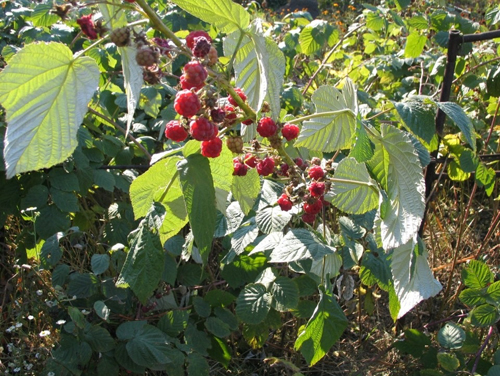
The bush is low, on average it grows up to 1.5 meters, of the standard type. It consists of 3-5 powerful, thick, strongly branching green shoots with slightly drooping tops. In this way, the bush sometimes resembles a small tree. Thorns are rare, small, but tough, reddish-purple in color, located throughout the shoot, but mainly concentrated in the lower part of it. Leaves are light green, whitish below, medium size, oval, slightly wrinkled, twisted, slightly serrated at the edges.
The berries of the Monomakh Cap are beautiful, aligned, elongated, blunt-conical in shape, with slight pubescence, rich ruby color with shine. Fleshy, firm, but juicy. Drupes are small, homogeneous, tightly interconnected. They come off the fruit well well, but with little effort. At the same time, they do not crumble and do not flow. The berries are really tasty, sweet, with a pleasant raspberry aroma. Sugar and acid are well balanced.
The variety compares favorably with really large and very large fruits, sometimes it gives out just gigantic sizes. On average, the weight of raspberries is 6-7 grams, the maximum reaches 10-15 grams, but there have been record 20 grams. For comparison, at the end of the season, an average large berry of a remontant strawberry, so that you better understand what is at stake, weighs 20-25 grams. Transportability and keeping quality of fruits are at a good level. The berries are little baked in the scorching summer sun.
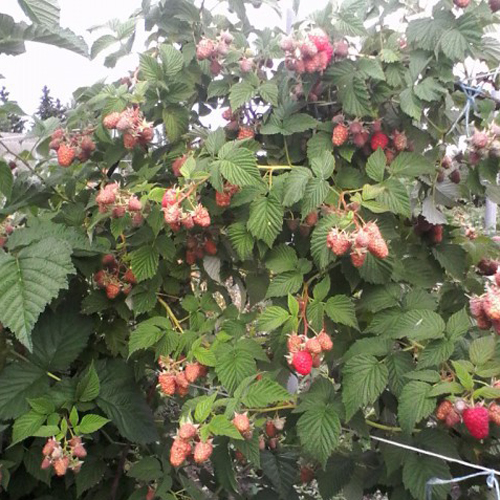
The potential productivity of the Monomakh Hat is very high - on average, 4.0-5.5 kg of berries from a bush, you can get up to 8 kg, but only in greenhouses.The autumn fruiting zone is 2/3 of the shoot. It is especially good if there is an opportunity to grow raspberries under cover (in a tunnel, greenhouse). Then the timing of the beginning of fruiting of the variety changes to earlier ones and the percentage of yield increases significantly. Or you can simply cover the bushes with agrofibre at the time of ripening in the fall. Such a simple technique also allows you to protect plants from a slight (up to -5 ° C) frost and accelerate the ripening process. Fruits, when grown in open ground without shelter, can withstand slight (-2-3 ° C) frosts.
Monomakh's hat cannot be considered a full-fledged “tutumer”. Often, some gardeners leave shoots for re-bearing, beginning in June. But the autumn harvest in this case is several times higher than the summer one, and such a technique can push the already late ripening periods towards winter. Raspberry root growth gives very little, practically without creating problems with its cutting when caring for the plant. But for reproduction, this is a significant disadvantage. To grow seedlings, it is necessary to harvest the uterine root in the fall, which is stored until February-March, and then in a warm room, it begins to germinate in a peat substrate. Previously, the root is soaked for a day in a solution of a fungicide with a high-quality root stimulator, you can add a fertilizer with a high phosphorus content. Also, for reproduction of Monomakh's caps, you can use late autumn digging and dividing the bush into separate shoots with its own root system.
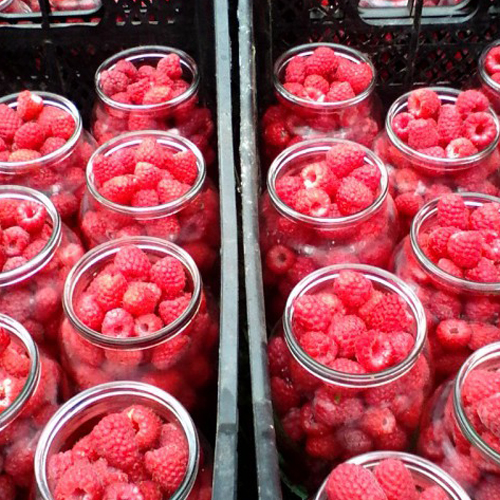
A very annoying and weak point of the variety is its high susceptibility to raspberry diseases: to fungal diseases - septoria, anthracnose; and viral - curly leaves and bushy dwarfism (the so-called looseness).
The plant can withstand frost down to -25 ° C, but when grown in a two-year culture as a tutimer, in the middle lane and in more northern regions, it needs bending and shelter for the winter. Monomakh's hat, among other things, is quite capricious in terms of agricultural technology and is demanding on the composition of the soil. She is very dependent on regular and abundant watering, especially during the hot season. With a lack of moisture, the fruits quickly and significantly become smaller. But by providing the plant with the necessary amount of moisture, the berries regain their excellent size and good taste. I would like to warn against excessive overflow - this will negatively affect the quality of the fruits: they greatly lose sugar and become fresh and watery. The same happens with prolonged rains, in addition to everything, the berry can become limp.
Excellent results are obtained using drip irrigation with mulching of the root zone of raspberries. Monomakh's hat is sensitive to the composition and acidity of the soil. Preferably the soil should be nutritious and pH neutral.
Weaknesses of the variety
- Honestly, reading how susceptible this species is to numerous diseases, it becomes just scary. And in addition, the fact that the originators themselves stopped multiplying it and deregistered it, further aggravates this fear. Lonely, gnarled, black raspberry stalks, leaves twisted in continuous ulcers and berries rotting on a moldy bush, crumble before our eyes like raspberry tears ... In fact, this is a big minus of the variety, but not the fact that the plant will definitely pick up everything these diseases. If you want to grow a Monomakh Hat, grow it. Just pay more attention to agricultural practices, especially plant protection and disease prevention. And in case of defeat, for example, by the "loose" virus, be ready to part with the plant without regret, destroying it, followed by spilling the soil with fungicides. Although chemical preparations are effective mainly against fungal diseases, this will definitely not be superfluous.Remember that during vegetative propagation of a plant infected with viral infections, all its offspring will also be infected. You cannot cure such raspberries. And the dwarf virus is generally transmitted with pollen. It will be good after uprooting sick (pah-pah-pah) plants to sow the beds with mustard, followed by embedding its green mass into the soil. It is an excellent fertilizer, it also repels pests and helps to get rid of pathogens in the soil.
- The strong dependence of raspberries on regular watering, temperature changes, berries Monomakh's caps can simply become limp in the rains.
- A capricious variety, demanding on the soil and agricultural technology, which does not turn out to be a problem-free language.
- Medium-late ripening period, extended fruiting period, the ability to get more than 60% of the crop in the open field only in the southern regions. In the northern regions, for example, the Leningrad region, the autumn fruiting of raspberries falls under the rainy season, the berries are sour, of poor quality, and a more or less tolerable harvest from the Cap of Monomakh will not work.
- Weak vigor, few replacement shoots.
Strengths of the variety
- Beautiful spectacular berries of a large and sometimes simply huge size, which can pleasantly surprise anyone. They fall under the category of "the envy of the neighbors".
- Abundant fruiting, the bush is literally strewn with berries.
- Slight thorniness, which practically does not create problems when harvesting and caring for raspberries.
- A low, slightly spreading shrub of the standard type.
- Delicious, sweet and aromatic, high quality berries.
As a result, it is up to you to decide - fearing possible problems and difficulties, choose a more persistent, unproblematic variety or, showing gardening excitement, grow your Monomakh Hat to everyone's envy!
Author: Maxim Zarechny.




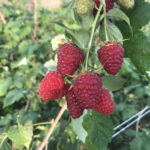
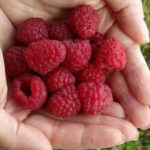



I cannot argue with the author of the article, since I do not have reliable information about the origin of the variety, but it has been growing on my site for 6 years already and I have no problems with it described (I bought seedlings, just in Kokino - from whom I will not tell) ... The bushes do not get sick and are not damaged by viruses - several times a season I carry out preventive treatments against fungal infections and leafhoppers that carry viruses. There are no difficulties with reproduction either - you just need to take a shovel and, stepping back from the base of the bush 25 - 30 cm, pierce the soil in several places (it is necessary to damage the roots, the buds will wake up on them, and shoots will begin to grow).
Raspberry remontant Monomakh's hat has been growing here for the fourth year. The berries are very large. Those that ripened in late summer - early autumn are sweet, autumnal, they got less sun, more acidic. Stems are thick, firm. I tried to grow as recommended for remontant varieties: in late autumn, cut the stems very low. For our conditions (the Ural region), this method did not justify itself. A cold spring in recent years delays the development of young shoots and, as a result, flowering and fruiting occurs later. Autumn also comes early. It turns out that the entire crop goes under the snow, not having time to ripen. This year I am trying another way of growing, on the advice of an agronomist from the nursery. I did not cut the stems completely in the fall, they should give early leaves and food for the growing stems. I also plan to install arcs and cover them in spring with covering material. Let's see what the result will be. If he does not justify himself, then I will refuse to grow remontant raspberries or will conduct it in the usual two-year mode.
We also have such a variety of raspberries. There are no problems with it, it grows well, even in our heavy soil. The overgrowth gives little, but it is better than a lot, as other varieties grow throughout the entire area. The fruits are tasty, elongated, really in the form of a cap. Another plus - the fruits do not crumble into grains when picked, all whole and strong.